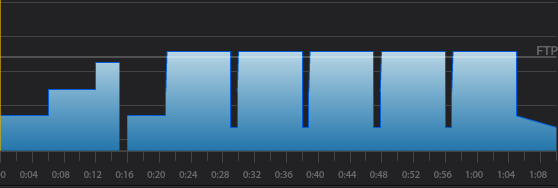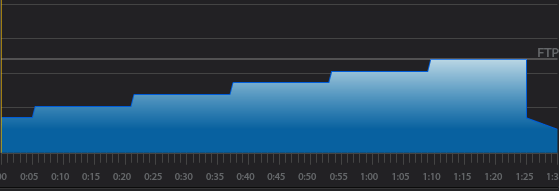40km TT Plans – Target Time Trial Power
The 40km time trial is the holy grail for aspiring and certified time trial specialists alike, and it also happens to comprise the bike leg of an international distance triathlon. Accordingly, we felt that putting together a set of training-stress-tiered 40km TT plans would be of interest to many of our subscribers. So, I set out to incorporate many of the tried and true tenets of time trial training with some of the newly emerging training techniques that veer more toward brain-training than physiological adaptation – the finished product, Target Time Trial Power (TTTP) training plans.
The governing principle with these plans is that in order to go fast, you have to train fast. Within the context of indoor power-based training, this reads more like, “In order to ride powerfully, you have to train powerfully”, or something along those lines. Too often I encounter riders whose only approach to fostering greater sustainable power is Sweet Spot efforts and over-unders. And while this is a valid approach and one that nearly always brings about measurable FTP improvements, there are more motivating ways to skin this cat.
Enter, target pace training, or in our case, target power training. Most of what’s written on target pace training applies to running, but it’s not much of a stretch to apply one endurance sport’s methods to another in hopes of reaping similar improvements. And that’s exactly what I’ve done here, thanks in equal parts to Matt Fitzgerald (running), Jan Olbrecht (swimming) and my own trial and error over numerous cycling seasons. And in the true sense of putting my money where my mouth is, this is the plan I’ll be following leading up to the Masters Nationals time trial and road race! These 3 plans are actually abbreviated versions of the 20-week Target Time Trial Power training plan (forthcoming) and are each 12 weeks in length.
We assume that you already have a reasonable level of base fitness, but if you haven’t yet completed at least 6 weeks of base conditioning, consider starting with either our Intermediate Base I or Intermediate Base II training plans because all 12-week versions of TrainerRoad’s TTTP training plans dive right into the first Build training phase.
TTTP Training Plan Structure
Each week we’ll increase training volume and/or intensity in pursuit of monthly increases in FTP. The exception to these weekly training stress increases is every 4th week’s routine recovery week where you’ll see a substantial reduction in work in order to allow your body an opportunity to more deeply absorb the stress inflicted over the prior 3 weeks. These recovery weeks will conclude with a time trial simulation you’ll use to adjust your FTP upward prior to the commencement of each successive phase of training. In addition to these recovery weeks, the 12-week TTTP training plans also include a structured Taper Week and Peak Week rounding out each plan just in time for your top-priority event, i.e. a 40-kilometer/25-mile time trial.
TTTP Training Plan Goals
The overriding goal of Target TT Power training is to improve your 40km time trial power and reduce your 40km time trial time, but this doesn’t mean you have to be a time trial specialist in order to benefit from these training plans.
We’ll accomplish these two general goals via three specific goals starting with improving your overall muscular contribution through Speed Workouts which increase your power over short durations. Secondly, we’ll improve your ability to sustain some of this higher power output via Intensive Endurance Workouts that will acquaint your mind and body with the stress that accompanies sustained power increases for lengthier periods of time. And thirdly, we’ll increase the length of time you can sustain a heightened power output up to the full duration of your 40km time trial with Extensive Endurance Workouts that will first bestow the ability to complete the time trial duration without rest and secondly the ability to sustain higher power output for increasing durations, eventually the entirety of your event.

Dicks – Intensive Endurance Workout
Put another way, Speed workouts will make you more powerful, Intensive Endurance workouts will make you more powerful for longer durations, and Extensive Endurance workouts will teach you how to ride an entire 40 kilometers/25miles at or very near your target pace. The ultimate objective is to bring these 3 components together just in time for race day thereby delivering you to the starting line fully capable of sustaining your target time trial pace for the entire race distance.

Tower – Extensive Endurance Workout
For those riders on the mid- and high-volume training plans, as well as low-volume riders who can find some additional weekly time, goals associated with a fourth and no less important component are added. Recovery Rides have been shown to increase resistance to muscle damage, enhance neuromuscular coordination (i.e. pedal economy), increase fat metabolism, and provide an opportunity for heat acclimation to name just a few of their potential benefits.
Calculating Target Time Trial Power
While a reasonable increase in sustainable power for most riders tends to fall right around 5% improvement in FTP, over the course of 12 weeks some riders may see greater or lesser gains dependent upon their incoming level of fitness, their weekly training hours, their training and racing experience level, and how their bodies respond to training stress, i.e. their overall ability to recover and adapt to high-intensity workouts. The fittest of riders may recognize their already near-peak fitness and see a relatively lesser level of improvement, perhaps more along the lines of 2-3% increase in FTP, while riders who are new to structured training can see improvements well above 5% FTP. But recognizable improvement is realistic and attainable for all riders who commit to this 12-week program.
Calculating your Target Time Trial Power will improve with each iteration of the TTTP training plans, but your first target power is prone to miscalculation if you don’t have a reasonably developed training background or if you are new to power-based training, as many riders are. Regardless, once you’ve performed your initial FTP assessment, simply multiply your FTP by your target percentage improvement, we recommend 5%. Example: FTP = 253w then your Target TT Power with a 5% goal improvement will be 253 x 1.05 = 266w.
Afterward, tuck this number away to be revisited following each monthly time trial or anytime you need to remind yourself of your goal. Again, the better you know yourself as a rider, the more likely it is that you’ll set a challenging but realistic target power. If you’re uncertain about your target power, start with 5% and you can modify your goal as you progress through any of the TTTP plans.
Reassessing Time Trial Power (FTP)
As mentioned earlier, every recovery week will conclude with an increasingly longer time trial simulation leading to the final day of the final week when you’ll complete your 40km time trial or similar event. During these time trial simulations, you’ll have the opportunity to reestablish your FTP based on that workout’s performance in order to scale the next training phase’s workouts relative to your consistently improving time trial power.
You’re also welcome and encouraged to increase your FTP anytime you have a series of workouts wherein you successfully complete each workout with an increased Workout Intensity. So even if you’ve recently assessed and estimated your FTP, perhaps you’ve completed your last 4 workouts with a 2 or 3% increase in Workout Intensity without sacrificing any interval precision. In cases such as these, there’s no need to wait until you’re next time trial simulation to increase your FTP.
Training Schedule Options
The proposed schedule places the key workouts on Wednesday, Friday and Sunday but many riders prefer a Tuesday, Thursday and Saturday schedule for their high-intensity workouts. In this case, simply switch swap Tuesday with Wednesday, Thursday with Friday, and Saturday with Sunday. Additionally, when time constraints limit your training options, your 3 key workouts are the most crucial components of the TTTP training plans. If at all possible, try to include a short, 20-minute Recovery Ride within 24 hours of each of these 3 workouts, and then squeeze in your Aerobic Endurance rides if and when possible.
Why Target a Specific Time Trial Power?
Setting a target power output brings a greater level of focus to your training and also helps you determine if your training is effective. Goal setting is a crucial component to any successful training program and the more specific your goals are, the more meaningful and informative your power data will be. Without specific goals, even the most dedicated and motivated athletes can fall well short of their potential.
As an example, a 12-week training plan that yields a 5% increase in FTP might be viewed as effective training, but just how effective can be better illustrated when put in relative terms, i.e. percentage of FTP. Look at it like this, Rider A has an FTP of 300w and Rider B has an FTP of 180w. If they both follow the same training plan and improve their FTP’s by 10 watts, this would only be a 3% improvement for Rider A while rider B’s FTP improved by more than 5%. Clearly, this training plan was more effective for Rider B and while Rider B may be happy with this level of improvement and choose to repeat this training plan just as it is prescribed, Rider A might be better served with some form of training plan modification.
Repeating TTTP Training Plans
Should you choose to repeat any of the TTTP training plans, we recommend a 2-6 week reduction in training intensity with no change in training volume. In other words, spend a number of weeks performing Tempo work but don’t drastically reduce the number of hours you spend on the bike. Regarding just how long your high-intensity training hiatus should be, the higher your plan’s TSS, the more weeks you’ll probably spend at this lower intensity. Riders in the low-volume plan might only need a couple weeks before they’re ready to start another TTTP plan while riders who completed the high-volume version might need as many as 5 or 6 weeks before they ramp things up again.
Training Phase Descriptions
Build 1
The overriding goal of Build 1 is to familiarize your mind and body with a greater level of work than your current capabilities will allow, a pace closer to the one you’ll sustain over the entirety of your 40km time trial. Each week’s Speed Workouts aim to make you more powerful, the Intensive Endurance workouts will help you hold some of this excess power for longer durations, while the Extensive Endurance workouts focus on teaching you how to ride an entire 40km (25 miles) at or very near your target pace.
Note: We’ve bypassed Base phase of training with these TTTP training plans assuming most riders have already completed their aerobic base conditioning. Depending on the quality of your base training, these speed workouts could prove to be slightly too challenging for riders lacking sufficient aerobic fitness. If this is the case, you can scale down these workouts in a couple of ways. The first, is to skip an occasional repeat by backpedaling for the interval duration. If you need to skip more than 1 interval per set (sets are 5-7 intervals) then your second course of action is to reduce the intensity of the entire workout by reducing the Workout Intensity as much as 7%. This will keep these intervals at a minimum of 120% of FTP and assure you that the same training response is targeted.
Build 2
During the second Build phase, all of the objectives of Build 1 remain intact with certain increased performance demands. The Speed Workouts will force you to sustain power well above FTP but substantially lower than PPO but for longer periods of time, Intensive Endurance workouts incorporate longer intervals and shorter rest periods in order to further your muscular endurance and reduce your need for recovery, and the Extensive Endurance workouts grow increasingly more intense in order to help you sustain time trial power for longer durations.
Peak
Over the course of this final phase of training, the weekly stress will reach an all-time high before descending just in time to leave you peaked and recovered for your top-priority time trial. Speed Workouts transform into combinations of suprathreshold intervals with less and less recovery between them thereby targeting aerobic power improvements, Intensive Endurance workouts grow longer still with even shorter rest periods and further your ability to sustain target power for your longest durations yet, and Extensive Endurance training pushes the power requirement to its highest level for durations at or close to your event duration.
Training Plan Descriptions
Low-Volume TTTP
The low-volume version of the Target Time Trial Power (TTTP) training plan has riders on the bike at least 4 times a week with the option of additional recovery rides added when possible. The total weekly stress will roughly range from 250-400 TSS and weekly hours will range from 2.5-4.5 hours only exceeding 5 hours if and when you choose to incorporate additional recovery rides into your training plan. Recovery rides are meant to complement each of your 3 key workouts each week and their duration and intensity depend on your level of fatigue. Ideally, these are performed anywhere from 4-24 hours after your key workout and typically last between 20-60 minutes.
Mid-Volume TTTP
The mid-volume version of the Target Time Trial Power (TTTP) training plan has riders on the bike at least 5 times a week with the option of 4 additional recovery rides added when possible. The total weekly stress will roughly range from 330-510 TSS but this can change substantially depending on the length and frequency of your recovery rides. The weekly hours will range from 7.5-9.5 hours, again subject to the frequency and duration of your recovery rides. Recovery rides are meant to complement each of your 3 key workouts each week and their duration and intensity depend on your level of fatigue. Ideally, these are performed anywhere from 4-24 hours after your key workout and typically last between 20-60 minutes.
High-Volume TTTP
The high-volume version of the Target Time Trial Power (TTTP) training plan has riders on the bike 6 times a week with the option of 4 additional recovery rides added when possible. The total weekly stress will roughly range from 450-670 TSS but this can change substantially depending on the length and frequency of your recovery rides. The weekly hours will range from 10-12 hours, again subject to the frequency and duration of your recovery rides. Recovery rides are meant to complement every key workout and there’s even an extra recovery ride following your early base ride totaling 4 per week. Recovery ride duration and intensity both depend on your level of fatigue, are performed anywhere from 4-24 hours after your workout and last between 20-60 minutes.



